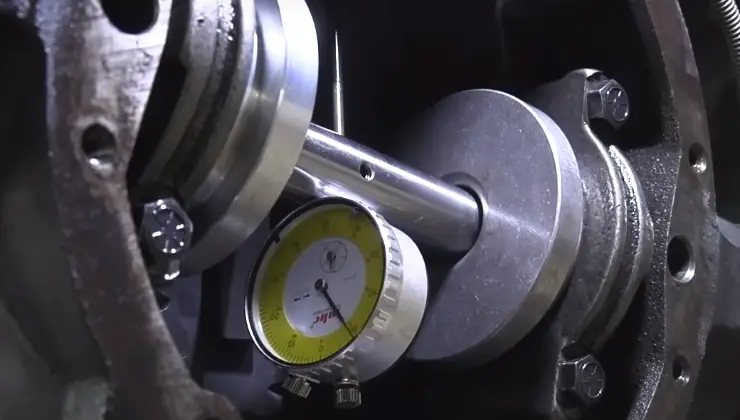Setting pinion depth is an essential aspect of ensuring optimal performance and longevity of a vehicle’s differential. The pinion depth refers to the distance between the centerline of the ring gear and the centerline of the pinion gear. Achieving the correct pinion depth ensures proper gear mesh, translating to efficient power transfer, minimal wear and tear, and reduced noise and vibration.
In this comprehensive guide, we’ll take a closer look at how to set pinion depth, the tools you’ll need, and some frequently asked questions. So, let’s dive in!
How to Set Pinion Depth
Before we get into the nitty-gritty of setting pinion depth, let’s take a quick look at the tools you’ll need:
- A dial indicator with a magnetic base
- A pinion depth gauge
- A micrometer
- A torque wrench
- A marking compound
- A set of shims
- A bearing puller
- A press
Now, let’s get started with the step-by-step guide:
Step 1. Remove the Differential Cover: The first step is to remove the differential cover and drain the fluid. You can use a pan to catch the fluid for reuse or disposal.
Step 2. Remove the Pinion Nut and Companion Flange: Once the differential cover is off, use a socket wrench to remove the pinion nut and companion flange. You can use a puller to remove the companion flange if it’s difficult to budge.
Step 3. Remove the Pinion Bearing: Next, use a bearing puller to remove the pinion bearing from the pinion shaft.
Step 4. Measure the Pinion Depth: With the pinion bearing removed, you can now measure the pinion depth using a pinion depth gauge. Place the gauge on the pinion shaft and adjust the gauge’s slider until it touches the ring gear’s tooth surface. Record the measurement.
Step 5. Determine the Required Shim Thickness: To determine the required shim thickness, subtract the measured pinion depth from the manufacturer’s recommended pinion depth. The resulting number represents the required shim thickness. For instance, if the manufacturer recommends a pinion depth of 2.875 inches, and you measure a pinion depth of 2.825 inches, you’ll need a shim that is 0.050 inches thick.
Step 6. Install the New Shim: Install the new shim and recheck the pinion depth using the pinion depth gauge. You may need to repeat steps 4 to 6 until you achieve the correct pinion depth.
Step 7. Install the Pinion Bearing: Once you achieve the correct pinion depth, you can now press the pinion bearing onto the pinion shaft. Use a press to ensure proper installation.
Step 8. Reinstall the Companion Flange and Pinion Nut: With the pinion bearing in place, you can now reinstall the companion flange and pinion nut. Use a torque wrench to tighten the pinion nut to the manufacturer’s recommended torque specification.
Step 9. Apply the Marking Compound: To check the gear mesh, apply a marking compound to the ring gear’s tooth surface.
Step 10. Check the Gear Mesh: Rotate the ring gear several times to transfer the marking compound to the pinion gear’s tooth surface. Use a dial indicator with a magnetic base to measure the gear mesh’s backlash and pattern. Adjust the shims as necessary until you achieve the correct gear mesh pattern.
Frequently Asked Questions
Here are some FAQs about the setting of pinion depth –
Q: Why is setting pinion depth important?
A: Setting pinion depth is important because it ensures proper gear mesh, translating to efficient power transfer, minimal wear and tear, and reduced noise and vibration. Failing to set the pinion depth correctly can lead to premature wear and failure of the differential.
Q: How do I know if I need to set the pinion depth?
A: You need to set the pinion depth if you’re installing a new ring and pinion gear set or replacing the pinion gear or bearing.
Q: Can I adjust the pinion depth by adding or removing shims from the ring gear?
A: No, you cannot adjust the pinion depth by adding or removing shims from the ring gear. The pinion depth can only be adjusted by adding or removing shims from the pinion gear.
Q: How tight should I torque the pinion nut?
A: The pinion nut should be torqued to the manufacturer’s recommended specification. Over-tightening or under-tightening the pinion nut can lead to premature wear and failure of the differential.
Q: How often do I need to set the pinion depth?
A: You only need to set the pinion depth when installing a new ring and pinion gear set or replacing the pinion gear or bearing. Otherwise, the pinion depth should remain unchanged.
Q: What happens if I set the pinion depth incorrectly?
A: If you set the pinion depth incorrectly, it can lead to premature wear and failure of the differential, increased noise and vibration, and reduced efficiency in power transfer. It’s essential to take the time to set the pinion depth correctly to ensure optimal performance and longevity of the differential.
Conclusion
Setting pinion depth is critical in ensuring optimal performance and longevity of a vehicle’s differential. By following the steps outlined in this comprehensive guide about how to set pinion depth and using the right tools, you can achieve the perfect gear mesh and enjoy efficient power transfer, minimal wear, tear, and reduced noise and vibration.
